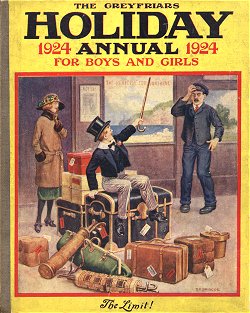 |
Publication of the month for December 2008
The Greyfriars Holiday Annual was an institution between the two world wars. Published every September, it was a compendium of the AP story papers best features. Long original stories of the famous schools, features, poems, articles of interest to boys and a play. The early volumes ran to 360 pages and retailed for 6 shillings.
This is a Cedar Creek Christmas story, published in the 1924 Holiday Annual, and probably an original story. Cedar Creek purported to be stories of Frank Richards' schooldays in Canada, as told by his good friend Martin Clifford! An interesting conceit, but one that worked well. The original Cedar Creek stories ran in the Boys Friend from 1917 to 1921, so this story would have been a welcome reunion for many readers.
Enjoy and have a merry Christmas!
Click the image to the left to open the comic in Adobe Acrobat format.
|
|
|
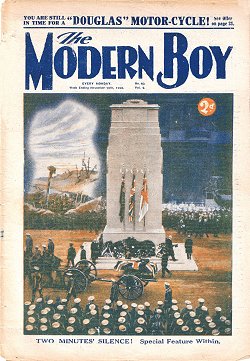 |
Publication of the month for November 2008
The Modern Boy was launched in 1928 by C M Down to take advantage of the growing market for boys' fiction. Charles Hamilton was commissioned to write a new series for it, and created the character of Ken King. The youthful skipper of the Dawn, known as King of the Islands, with his Australian mate Kit Hudson sailed the lonely Pacific ocean for more than 4 years (though his last appearance was in the second Magnet South Seas holiday series of 1938). Early stories also carried the by-line of Sir Alan Cobham, a famous aviation pioneer, but his name soon disappeared
The stories were character driven, and enjoyable to read; though the social and economic conditions that gave the series its colour (cannibal tribes, pirates involved in the pearl and slave trades, benevolent colonial powers) were out-dated long before the series started.
This issue also contains serial stories by Geo E Rochester, Stacey Blake and Tom Rogers.
Click the image to the left to open the comic in Adobe Acrobat format.
|
|
|
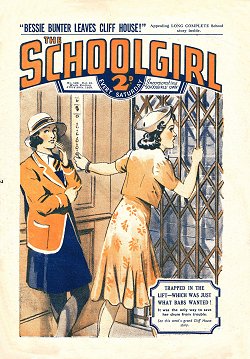 |
Publication of the month for October 2008
Alongside the famous story papers for boys produced by the Amalgamated Press were a smaller stable of papers for girls. Easily the most famous set of schoolgirl characters were the girls of Cliff House School.
Created in the pages of The Magnet by Frank Richards, Marjorie Hazeldene, Clara Trevlyn, Babs, Mabs and Bessie Bunter were given their own paper "The School Friend" in 1919. The first few stories were written by Frank Richards under the pseudonym Hilda Richards, but he had too many other commitments and a variety of other writers soon took over.
The School Friend became The Schoolgirl in 1929, and continued through until 1940. This is an issue from 1939 written by John W Wheway, the most prolific of the Hilda Richards authors who took over.
Click the image to the left to open the comic in Adobe Acrobat format.
|
|
|
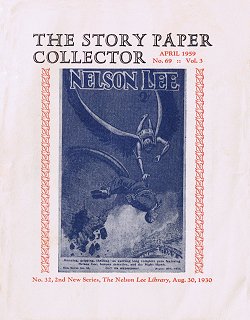 |
Publication of the month for September 2008
Australia had the Golden Hours and Golden Years magazines, Britain had the Collector's Digest and Canada had the Story Paper Collector.
Edited and published by William Gander, it originally consisted of articles describing the chronology of the famous papers, with small ads from Mr Gander and other collectors seeking to fill the elusive gaps in their collections. It became an essential source of information for collectors.
Published every 3 months in irregular print runs (depending on how many were intending to be mailed out), it continued up to issue 95 in 1966, ending only on the event of its publisher's death. This is an issue from 1959. You can read the last 20 issues (from 1961 to 1966) on the Friardale site, in the ephemera section.
Click the image to the left to open the comic in Adobe Acrobat format.
|
|
|
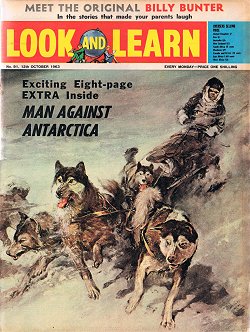 |
Publication of the month for August 2008
This is another peculiarity. Look & Learn was an educational comic published by Fleetway House (as Amalgamated Press became) from 1962 to 1982. I can remember having it delivered weekly in the early 1970's, and turning immediately to the Trigan Empire story. Classic features and illustrations are currently being reissued via subscription.
Anyway, in the comic's early days the editor had the idea of reprinting Frank Richards' Magnet stories in abbreviated format. Issue 91, from 1963 contained the first instalment. The experiment was not a success, and was abandoned after 15 issues.
It probably didn't help that two of the three stories serialised were by substitute authors, but the main reason for failure was that the instalments were too short to allow any kind of character or plot development. See for yourself by turning to page 30.
Click the image to the left to open the comic in Adobe Acrobat format.
|
|
|
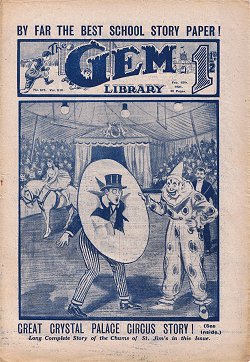 |
Publication of the month for July 2008
This is the first Gem issue to appear in this slot. A rare blue and white Gem from 1921, the Gem was gradually pulling out of a period of sub authors into what would become possibly it's best year ever, 1922.
This story, although it can be read on its own, forms part of a four part series featuring the arrival of Kit Wildrake, who would become ubiquitous over the next 18 months. Wildrake was an interesting character - assertive, intelligent, good at school and games. He came to the fore particularly in mystery series that required a leader to puzzle out the clues and find the villain of the piece.
This issue also features an episode of The Invisible Hand, a serial linked to a Saturday Morning Pictures series of the same name. An early tie in between comics and cinema, it's not known how the collaboration came about, or how successful it was.
And finally on page 19, an advert for the "famous" Harlene hair products that graced (or so it seemed) almost every Magnet and Gem through the late teens and early 1920s.
Click the image to the left to open the comic in Adobe Acrobat format.
|
|
|
|
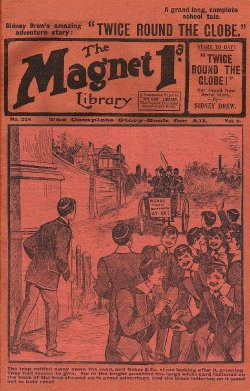
|
Publication of the month for June 2008
This is the first Magnet issue to appear in this slot. Unique in my collection as the only red Magnet which was not reprinted by Howard Baker, and had not appeared online as part of the Magnet facsimiles site
[now sadly gone].
The original Magnet sadly is somewhat battered, where some previous owner has trimmed the page edges; and the only part of the original cover was the main illustration. For this electronic version I've recreated a cover using a scan of another red Magnet.
This story features the inimitable Horace Coker in full flow, a visit by Alonzo and Peter Todd; and a spurious invitation to tea with a master (a prank that saw later and more effective use at Rookwood in Boy's Friend 815, reprinted in the 1928 Greyfriars Holiday Annual).
Note in particular the illustration of Mr Prout, Fifth Form Master, on page 3. A scrawny man with glasses and excessive whiskers, a far cry from the portly and pompous man of later Magnet stories and illustrations.
|
|
|
|
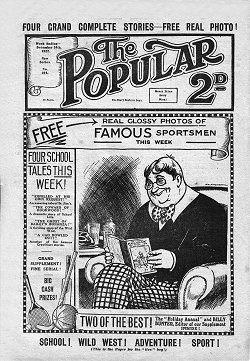
|
Publication of the month for May 2008
The Popular, like last month's Greyfriars Herald, was another AP publication affected by the first world war. The first series of the Penny Popular ran from 1912 to 1918, when it was amalgamated with the Boy's Friend due to the paper shortage (having dropped from 32 to 16 pages across the previous 4 years).
The second series appeared a year later in 1919 and ran until January 1931, when it was renamed the Ranger. During its heyday it followed the same format as the first series: reprinted stories of Greyfriars, St. Jim's and Rookwood; with an occasional serial, possibly a reprint of another school story (Cedar Creek, St. Frank's). Although there were for a time "original" stories of Greyfriars et al, these were written by sub writers and not often of a high standard. The only original stories the Popular ever printed of any merit were those of the Rio Kid, which you can read here.
The Popular here is from 1922 and includes classic reprints of Greyfriars, St. Jim's, Rookwood and Cedar Creek, as well as a serial by Victor Nelson and an edition of Billy Bunter's Weekly. Enjoy
|
|
|
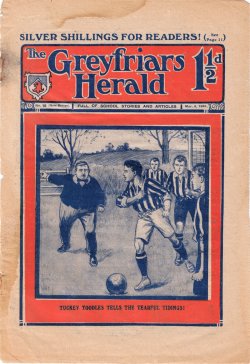 |
Publication of the month for April 2008
The Greyfriars Herald first appeared as the subject of stories in the red Magnet around setting up a school paper - in particular M 158-159, 296 and 306. Unlike the light-hearted introduction to Tom Merry's Weekly in the blue Gems, the Herald was eventually a more serious and longer lived affair. Following a readers' poll in the Magnet the Greyfriars Herald was first published as a separate paper on 20th November 1915, and ran for 18 issued before the first World War paper shortages killed it off.
It reappeared on 20th October 1919 and ran for more than a year before folding again. It featured stories of Jack Drake at St. Winifreds (much later reprinted in the blue and yellow Gem of the late 1930's), spoof stories of Herlock Sholmes by Peter Todd (aka Charles Hamilton), as well as a range of stories, poems and articles by the pupils at Greyfriars. Issues 3 and 9 of the New series were reprinted in Howard Baker Magnet Volume 41. Here for your delight is issue 19 from March 1920.
The Herald was revived, initially as a four page centrepiece of the Magnet from issue 673 onwards, before being replaced by Harry Wharton's Cricket & Football Supplements. The Second series ran from Magnet 1169 to M 1268, and was initially tied in to the current Greyfriars storyline. The Third series started up in M 1285 and ran to the end of the Magnet in 1940. Issues 99 onwards featured a short St. Sam's story by "Dicky Nugent" [George Richmond Samways] as well as various Greyfriars news items.
|
|
|
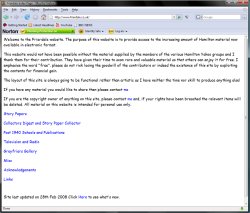
|
Publication of the month for March 2008
This month's publication is something different - a new website. What will in time become a repository of all things Hamilton, it already includes scans of a plethora of vintage fiction - from Martin Clifford, Ralph Redway and Frank Richards, as well as Charles Hamilton writing under his own name!
Thanks to the dedication of members of the Yahoo discussion groups it will gradually build up as a complete a picture as possible of the range of Hamilton's fiction. Most documents can be read on-line or downloaded and read at your leisure.
|
|
|
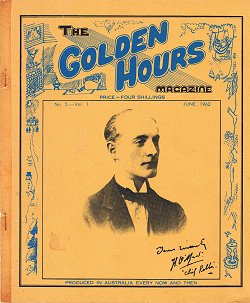 |
Publication of the month for February 2008
Britain had the Collector's Digest, Canada had the Story Paper Collector, and Australia had the Golden Hours magazine. 7 issues were produced over a 4 year period from 1960 by Syd Smith, of the Sydney Old Boys Book Club.
It's lack of frequency was more than made up for by the quality of the contents - articles by a range of collectors and those who were part of the Amalgamated Press.
This issue includes reminiscences of Hedley P A O'Mant by H. W. Twyman, Fleetway in the Twenties by E. L. McKeag and Frank Richards the down to earth author were part of the Amalgamated Press.
A piece of nostalgia. Visit the Collecting Books and Magazines site for more details on Golden Hours and its successor Golden Years.
|
|
|
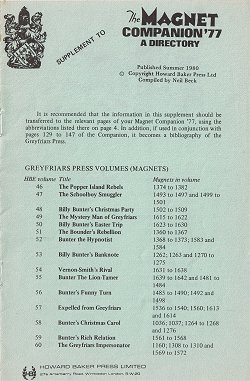 |
Publication of the month for January 2008
This is a piece of ephemera. Those of you who collect the Magnet will know that Howard Baker published three Magnet listings in 1971, 1977 and 1986. Each refined the details of its predecessor, and added in the increasing number of facsimile volumes published.
For those with the '77 companion, this later addition was a necessary corrective. Of course those whose collecting bordered on obsession (such as me) had already annotated their original '77 hardback volume.
Anyway, a little something to illustrate how dedicated Bill Howard Baker was in serving his loyal customers.
|
|